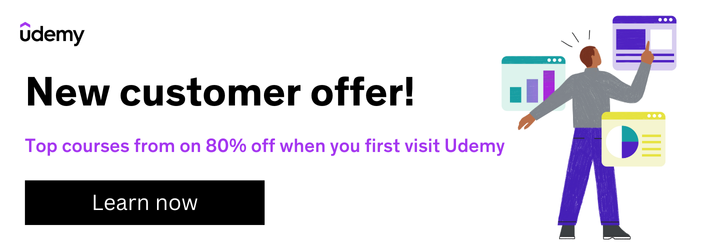Description
Lo que aprenderás
-
You will learn thande Introduction to Design Thinking (What is Design Thinking), Definitions and Origin, the role of creativity Innovation
-
Learn Comparison with Traditional problem solving, Importance of Design Thinking, Why Design Thinking matters, Why Businesses and Org use Design Thinking
-
Learn Human centered vs. Process Centered approach, Success stories; How Design Thinking Transforms Businesses
-
Learn The Five- Stage Design Thinking Process, Real world applications, Activities – Case study
-
Learn about Prototype – Bringing ideas to Life. Low-Fidelity vs. High-Fidelity prototypes, Storyboarding, Wireframes, Mockups
-
Learn about Tools and Techniques in Design Thinking, Empathy and Research Tools, User Personas, Journey mapping, Empathy Maps
-
Learn Ideation and Innovation Techniques, SCAMPER, Mind mapping and Brainstorming Blue Ocean strategy and TRIZ, Lateral thinking and Reverse Thinking
-
Learn Prototyping and Testing Tools, Paper Prototyping, Digital Prototyping with Figma, Adobe XD, or Sketch. Usability Testing Methods
-
Discover how to gain knowledge of Applying design thinking to business and social challenges. Sustainability and Social Impact Projects
-
Learn The Role of Leadership in Design Thinking. Scaling Design Thinking Beyond Projects. Embedding Design Thinking in Corporate Strategy
Description
Take the next step in your career! Whether you’re an up-and-coming professional, an experienced executive, aspiring manager, budding Professional. This course is an opportunity to sharpen your Design Thinking, enhance your assessment and planning efficiency, capabilities, increase your efficiency for professional growth and make a positive and lasting impact in the business or organization.
With this course as your guide, you learn how to:
-
All the basic functions and skills required to understand and apply the Introduction to Design Thinking (What is Design Thinking), Definitions and Origin,
-
Transform the Five- Stage Design Thinking Process (Introduction). The five key stages of Design Thinking are-, Empathize -Understanding Users. The power of empathy is Innovation, Methods for building Empathy, Creating an Empathy map. . Define; Clearly articulating the problem, Turning observations into insights. Defining the User Problem. Writing a problem statement. Ideate – Generating creative Solutions. Techniques; Brainstorming Scamper Crazy 8s. Lateral thinking and Divergent thinking, Selecting the best ideas.
-
Get access to recommended templates and formats for detailed information related to the fundamentals of Design Thinking.
-
Learn about impact on understanding Tools and Techniques in Design Thinking, Tools and Techniques in Design Thinking, Empathy and Research Tools, User Personas, Journey mapping, Empathy Maps. Ideation and Innovation
-
Invest in understanding Design Thinking today and reap the benefits for years to come by enhancing Techniques, SCAMPER, Mind mapping and Brainstorming Blue Ocean strategy and TRIZ, Lateral thinking and Reverse Thinking, Prototyping and Testing Tools, Paper Prototyping, Digital Prototyping with Figma, Adobe XD, or Sketch. Usability Testing Methods. Activity 1. Create a journey Map for a specific User Experience. Activity 2. Conducting a Quick Usability Test on a Prototype. Implementing design thinking in business.
The Frameworks of the Course
Engaging video lectures, case studies, assessment, downloadable resources and interactive exercises. This course is designed to explore the Introduction to Design Thinking (What is Design Thinking), Definitions and Origin, the role of creativity and Innovation, Comparison with Traditional problem solving, Importance of Design Thinking, Why Design Thinking matters, Why Businesses and Organizations use Design Thinking, Human centered vs. Process Centered approach, Success stories; How Design Thinking Transforms Businesses. Real world applications, Activities
The course includes multiple case studies, resources such as formats, templates, worksheets, reading materials, quizzes, self-assessments, film studies, and assignments to deepen and enhance your understanding of the The Five- Stage Design Thinking Process (Introduction). The five key stages of Design Thinking are-, Empathize ,Define, Ideate, Prototype and Test.
-
In the first part of the course, you’ll learn the details of the You will learn Introduction to Design Thinking (What is Design Thinking), Definitions and Origin, The role of creativity and Innovation, Comparison with Traditional problem solving, Importance of Design Thinking, The Five- Stage Design Thinking Process (Introduction). The five key stages of Design Thinking are-, Empathize, Define, Ideate, Prototype and Test.
-
In the middle part of the course, you’ll develop a deep understanding of Tools and Techniques in Design Thinking, Tools and Techniques in Design Thinking, Empathy and Research Tools, User Personas, Journey mapping, Empathy Maps. Ideation and Innovation Techniques, SCAMPER, Mind mapping and Brainstorming Blue Ocean strategy and TRIZ, Lateral thinking and Reverse Thinking, Prototyping and Testing Tools, Paper Prototyping, Digital Prototyping with Figma, Adobe XD, or Sketch. Usability Testing Methods.
-
In the final part of the course, you’ll develop knowledge Applying design thinking to business and social challenges. Sustainability and Social Impact Projects., Government and Policy., Healthcare and Education Application, Managing Stakeholder Collaboration. Cross- Functional Teamwork.
Course Content:
Module 1: Introduction to Design Thinking
Module 2: The Five-Stage Design Thinking Process
Module 3: Tools & Techniques in Design Thinking
Module 4: Implementing Design Thinking in Business
Module 5: Design Thinking for Problem Solving
Module 6: Capstone Project & Certification
¿Para quién es este curso?
- Professionals with knowledge or interest in basic Design Thinking and or UX
- New professionals who are looking to achieve success through the Design Thinking implemetation
- Existing executive board directors and managing directors who are looking to enhance engagement and foster innovation within their teams and organisations
Ver másVer menos






Reviews
There are no reviews yet.